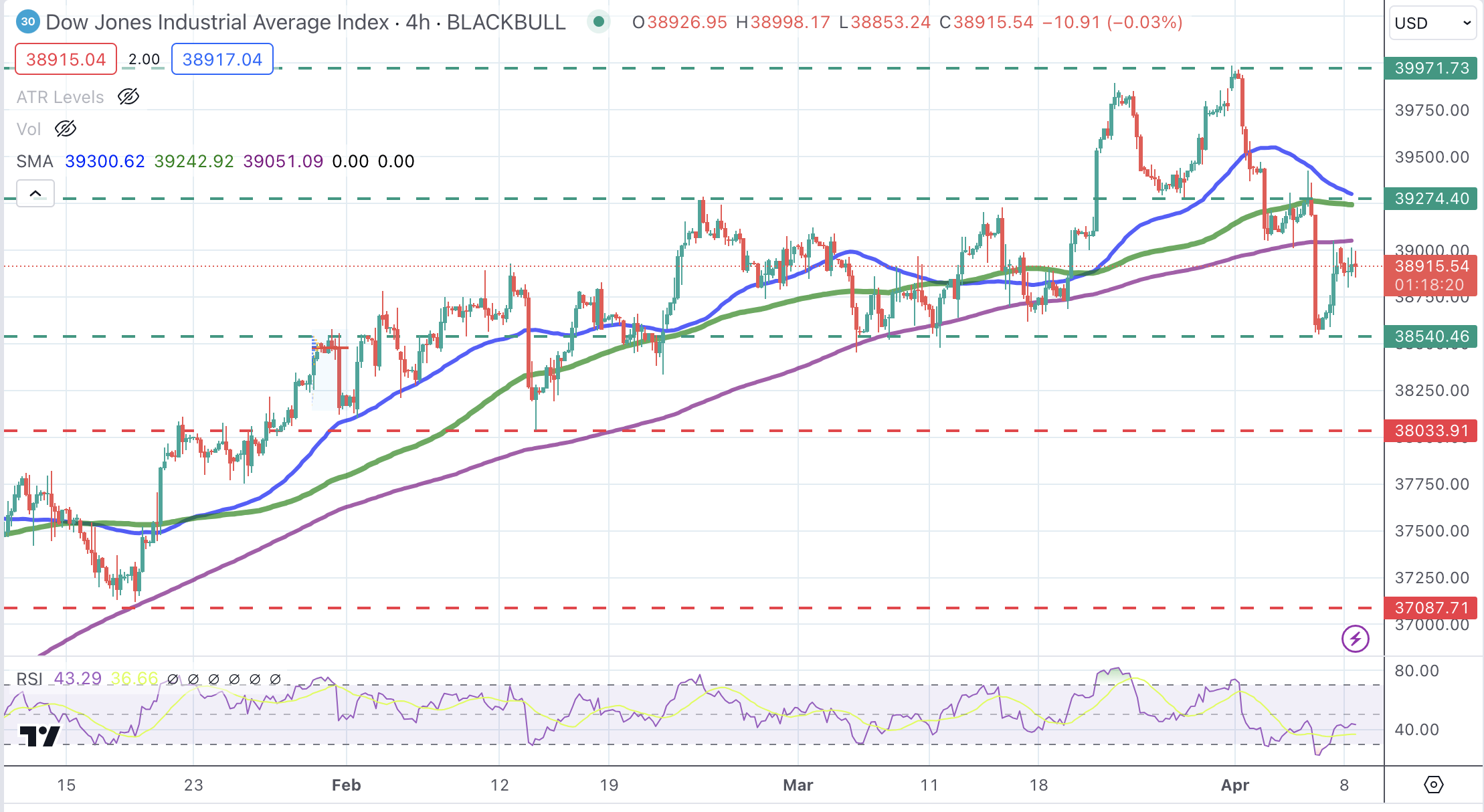Dow Jones Industrial Average consolidates with the market awaiting US CPI data

- Wall Street opens the week with marginal gains with investors relieved by decline in Oil prices.
- Dow Jones treads water near 39,000 level as rebound from Friday’s high stalls.
- Bias remains skewed to the downside with all eyes on Wednesday’s US CPI figures.
The Dow Jones Industrial Average (DJIA) has opened the week with minor advances, favoured by some risk appetite. Oil prices have retreated from multi-month highs as tensions in the Middle East ease somewhat, which has provided some relief to equity investors on Monday.
The market, however, is in a wait-and-see mode with traders reluctant to take excessive risks ahead of Wednesday’s US Consumer Prices Index data. US Inflation is expected to have accelerated to 3.4% in March from the 3.2% yearly rate in February, although core CPI is seen cooling to 3.7% from a 3.8% annual reading in the previous month.
All the main Wall Street indices are positive on Monday. The NASDAQ is leading with a 0.14% advance to 16,271, the S&P 500, is 1.2% above opening levels, at 5,210, and the Dow Jones gains less than 0.1% at 38,928.
Dow Jones news
Down to sectors, Consumer Discretionary is leading gains with a 0.8% advance, followed by Real Estate, which is up 0.5%. At the bottom of the ranking on Monday is the Health sector, dropping by 0.48%, and Technology, 0.25% below Friday’s close.
Nike (NKE) is the best Dow performer on Monday with a 1.42% increase to $90.11, followed by 3M (MMM) gaining 0.97% to $91.90. On the losing end, Intel (INTL) leads losses with a further 1.6% decline to $38.05, followed by Merck (MRK), 1.5% down to $126.02.
Dow Jones technical outlook
The Dow Jones index is trading practically flat with oscillators showing a lack of clear direction. The DJIA is still in a bearish correction from the 39,986 historic high hit in late March.
The recovery attempt from Friday’s lows has stalled below previous lows, at the 39,000 area, and with a supply zone at the 39,250 area likely to offer significant resistance. On the downside, the 38,540 level is still in play and might be revisited if US CPI posts a positive surprise on Wednesday. Below here, 38,035 would be exposed.
Dow Jones Index 4-Hour Chart
Nasdaq FAQs
The Nasdaq is a stock exchange based in the US that started out life as an electronic stock quotation machine. At first, the Nasdaq only provided quotations for over-the-counter (OTC) stocks but later it became an exchange too. By 1991, the Nasdaq had grown to account for 46% of the entire US securities’ market. In 1998, it became the first stock exchange in the US to provide online trading. The Nasdaq also produces several indices, the most comprehensive of which is the Nasdaq Composite representing all 2,500-plus stocks on the Nasdaq, and the Nasdaq 100.
The Nasdaq 100 is a large-cap index made up of 100 non-financial companies from the Nasdaq stock exchange. Although it only includes a fraction of the thousands of stocks in the Nasdaq, it accounts for over 90% of the movement. The influence of each company on the index is market-cap weighted. The Nasdaq 100 includes companies with a significant focus on technology although it also encompasses companies from other industries and from outside the US. The average annual return of the Nasdaq 100 has been 17.23% since 1986.
There are a number of ways to trade the Nasdaq 100. Most retail brokers and spread betting platforms offer bets using Contracts for Difference (CFD). For longer-term investors, Exchange-Traded Funds (ETFs) trade like shares that mimic the movement of the index without the investor needing to buy all 100 constituent companies. An example ETF is the Invesco QQQ Trust (QQQ). Nasdaq 100 futures contracts allow traders to speculate on the future direction of the index. Options provide the right, but not the obligation, to buy or sell the Nasdaq 100 at a specific price (strike price) in the future.
Many different factors drive the Nasdaq 100 but mainly it is the aggregate performance of the component companies revealed in their quarterly and annual company earnings reports. US and global macroeconomic data also contributes as it impacts on investor sentiment, which if positive drives gains. The level of interest rates, set by the Federal Reserve (Fed), also influences the Nasdaq 100 as it affects the cost of credit, on which many corporations are heavily reliant. As such the level of inflation can be a major driver too as well as other metrics which impact on the decisions of the Fed.
